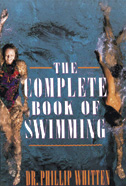Finding Fitness in the Pool

It’s been important to me for two reasons: First, I’m convinced (as others in this magazine have argued) that the watershaping industry is doing both itself and its clients a disservice by not promoting the remarkable healthfulness of aquatic activity. I think this is a deficit we desperately need to address — and also that this effort must begin on a solid base of knowledge and fact. Second, as I progress through my forties, I’m finding that running is becoming more and more difficult because of hip problems; my intention is to turn to the water to maintain my physical fitness, but I want to know more about it and how to do it right.
So far, the best resource for information about swimming I’ve found is The Complete Book of Swimming by Dr. Phillip Whitten (Random House, 1994). It’s older than some other volumes I’ve found, but I think it’s the best because it deals with the broad health benefits of swimming instead of focusing only on specific swimming techniques — which seems to be the main target of most of the others I’ve seen.
Whitten breaks his discussion into three topic areas, the first of which is a detailed rundown of the almost innumerable ways that swimming benefits the body. Not only is it easy on the joints (which we all should know by now) and great cardio exercise, but it’s also great for just about every other part of a body, including the skin, overall muscle tone, the heart and mental well-being, to name just a few. I was amazed to learn that people who swim regularly have life expectancies averaging 20 years longer than those that don’t — a point he lays on the line by calling swimming the true “fountain of youth.”
The book’s second section deals with different swimming strokes, which for those who are committed to improving the value of their swimming workouts will, I can imagine, be extremely helpful. The third section is really fascinating: It covers a range of issues that basically encompass the “swimming lifestyle” and leads him into discussions of the nature of training, the lives of competitive swimmers and how swimming is one of the best-known treatments for depression.
Now you can purchase the title reviewed here — and other books reviewed by Mike Farley — through our online WaterShapes Store! Click here.
It’s a bit off the beaten track, but this section also includes information on the sex lives of swimmers: Whitten cites studies indicating that so-called “master swimmers” in their 80s have sex on average as often as people in their 20s and 30s — nearly eight times a month. That’s an enticing statistic — and one that speaks volumes about the fundamental benefits of the swimming lifestyle.
The doctor comes to the ultimate observation that people who swim are healthier, happier, look better, enjoy life more and live longer than those who don’t. As watershapers, we create product that promise to bring those benefits to our clients: Isn’t it about time we start making that point a bit more sharply? I, for one, certainly think so.
Mike Farley is a landscape designer with more than 20 years of experience and is currently a designer/project manager for Claffey Pools in Southlake, Texas. A graduate of Genesis 3’s Level I Design School, he holds a degree in landscape architecture from Texas Tech University and has worked as a watershaper in both California and Texas.









